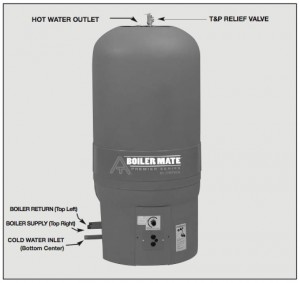 In line with efficient distribution of hot water and hot water pipe insulation, this credit is the last in this section that awards points for efficient hot water systems. It is only, however, required for the prescriptive pathway (unlike 7.1 and 7.2, which are required for both performance and prescriptive pathways). Here, the credit is divided into minimum efficiency standards for gas water heaters, electric water heaters, or solar water heaters. The measure is EF, or energy factor, and there are different requirements for different size hot water heaters (ranging from 40 to 80 gallons). According to the US Department of Energy:
In line with efficient distribution of hot water and hot water pipe insulation, this credit is the last in this section that awards points for efficient hot water systems. It is only, however, required for the prescriptive pathway (unlike 7.1 and 7.2, which are required for both performance and prescriptive pathways). Here, the credit is divided into minimum efficiency standards for gas water heaters, electric water heaters, or solar water heaters. The measure is EF, or energy factor, and there are different requirements for different size hot water heaters (ranging from 40 to 80 gallons). According to the US Department of Energy:
The energy factor (EF) indicates a water heater’s overall energy efficiency based on the amount of hot water produced per unit of fuel consumed over a typical day. This includes the following:
- Recovery efficiency – how efficiently the heat from the energy source is transferred to the water
- Standby losses – the percentage of heat loss per hour from the stored water compared to the heat content of the water (water heaters with storage tanks)
- Cycling losses – the loss of heat as the water circulates through a water heater tank, and/or inlet and outlet pipes.
The higher the energy factor, the more efficient the water heater. However, higher energy factor values don’t always mean lower annual operating costs, especially when you compare fuel sources….It is also important to consider the size, the fuel type, the overall cost, and first hour rating.
As I have mentioned in other postings, we have a hot water tank that is preheated by the ground-source heat pump — whenever the pump is on (i.e., we are either heating or cooling the house, which is more than half the time), our hot water is virtually free. We have a back-up gas boiler that heats the domestic hot water when the pump is not running–like right now. (In this case, our gas bill will go up marginally but our electric bill will go down.) Ours is an 80-gallon Boilermate tank by Amtrol, which I learn is called an “indirect-fired water heater.”
So now I am on a wild goose chase trying to find the EF rating for this model number. The LEED Reference Manual mentions a website that provides energy factors for equiupment from various manufacturers: www.ahrinet.org, but it does not list Amtrol as a manufacturer. So, I look it up in my owner’s manual. No mention of it. I call the technical support help line from Amtrol. No answer. I email them. No answer. I call back, and talk to Pete, who is helpful. Pete says there is no energy factor rating for an indirect water heater, because it is a side-arm tank — it is heated by the boiler (or preheated by the ground source heat pump). Duh – silly me. So, the efficiency of our domestic hot water equipment depends on the efficiency of our gas boiler, which was already rated in EA 6 – Space Heating and Cooling Equipment. The rating for the boiler is just for fuel efficiency, and does not take into account recovery efficiency, standby losses, or cycling losses.
I go back to the LEED Reference Manual, where I find this clarification:
Projects using alternative water heating designs, such as a small-tank, combination tankless/tank systems, or heat-pump preheat systems, should submit a Credit Interpretation Request or use the performance pathway in EA1.
Ahhh. Well, we are using the performance pathway in EA1. But I wanted to know how many points we would get for our efficient hot water equipment. Since I am not going to submit a Credit Interpretation Request — this is just a quest for understanding, after all — I am going to assume that we would get the maximum 3 points available for this credit.
EA Prescriptive Path points so far: 12
